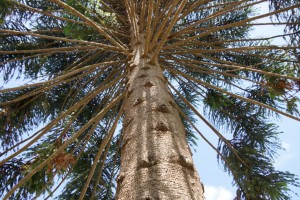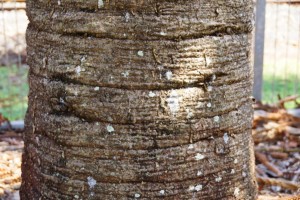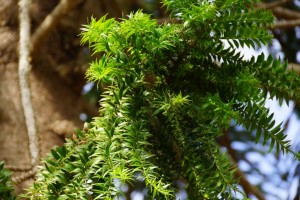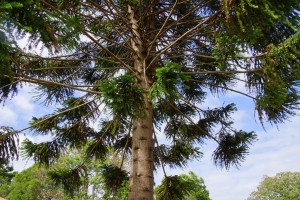The Australian ‘Bunya Pine’ is of the ancient coniferous family Araucariaceae, a species that has survived from the time of the dinosaurs !!! It is the most ancient of all surviving Araucariaceae. Fossil evidence suggests that it has existed for well over 100 million years. The closest relatives to the ‘Bunya Pine’ discovered so far are a South American fossil species, A. mirabilis which dates back to the Jurassic period (205 to 145 million years ago) and were found in the southern end of South America, shared by Argentina and Chile.
 In fact, the botanical name, ‘Araucaria’ is derived from ‘Araucanos’, a province of southern Chile where the first Araucaria was discovered. They became entirely extinct in the northern hemisphere toward the end of the Cretaceous period and are now found only in the southern hemisphere. Araucaria is a genus of conifers consisting of some 18 species.
In fact, the botanical name, ‘Araucaria’ is derived from ‘Araucanos’, a province of southern Chile where the first Araucaria was discovered. They became entirely extinct in the northern hemisphere toward the end of the Cretaceous period and are now found only in the southern hemisphere. Araucaria is a genus of conifers consisting of some 18 species.
A. bidwillii – the ‘A.’ stands for ‘Araucaria’, and the ‘bidwillii’ is in honour of John Carne Bidwill (b. 5 Feb 1815 – d. 16 Mar 1853):
” . . . 1853 – John C. Bidwill, died at the early age of 38. He was a remarkable man who did more than any other man to organise the small outpost of Maryborough and surrounding District. He was also a Botanist. The Bunya Pine Tree “Arucaria Bidewillii” was named after him . . . “
Source: Excerpt – ‘Geological Society of Australia – Queensland Division – Guide Book – Maryborough Basin Field Conference – October 10-11, 1964’ – pp 9
There are three Australian members of the Araucaria genus: A. bidwillii (‘Bunya Pine’ from Queensland), A. cunninghamii (‘Hoop Pine’ from Queensland and New South Wales) and A. heterophylla (‘Norfolk Pine’ from Norfolk Island).
The common name of the ‘Bunya Pine’ is derived from the Aboriginal name, of which there were a number of versions depending on the Aboriginal dialect: bunya-bunya, bunyi, booni-booni, bonya, banza-tunza, banua-tunya, bahnua, bon-yi, banya bunya, bunnia, and bonyi-bonyi. Though it is not truly a ‘Pine’, its common name is likely to have come about due to the similarities of the wood to a pine – being a soft wood and light in colour.
 In the wild, the ‘Bunya Pine’ can exceed 50 m in height (that’s equivalent to a 15 storey building !!), some 1.5 m in diameter, and, live for 300 to 500 years. It occurs mainly in south-eastern Queensland between Gympie and the Bunya Mountains, north east of Dalby. There are also small, isolated occurrences on Mt. Lewis and at Cunnabullen Falls in northern Queensland. Its adaptability means it can be found in moist valley floors as well as dry upper slopes and ridge tops – generally within some 160 km of the coast.
In the wild, the ‘Bunya Pine’ can exceed 50 m in height (that’s equivalent to a 15 storey building !!), some 1.5 m in diameter, and, live for 300 to 500 years. It occurs mainly in south-eastern Queensland between Gympie and the Bunya Mountains, north east of Dalby. There are also small, isolated occurrences on Mt. Lewis and at Cunnabullen Falls in northern Queensland. Its adaptability means it can be found in moist valley floors as well as dry upper slopes and ridge tops – generally within some 160 km of the coast.
 The appearance of the ‘Bunya Pine’ is quite distinctive with its straight trunk, which is usually free of branches for the bottom two-thirds of its height. The bark is generally dark brown to black in colour and persistent, thin scales. The crown of the tree is symmetrical and dome shaped. As the tree matures, the pointed apex flattens out. The branches at the top of the tree are prickly and stretch out, without any further branching, sporting clusters of leaves only at the ends. The leaves, themselves, are very short, hard and narrow, generally oval in shape, tapering to a sharp point at the end. Like Cycads, there’s only a brief window for the browsing dinosaur, when the new leaves first emerge, before they harden and become too prickly to eat . . .
The appearance of the ‘Bunya Pine’ is quite distinctive with its straight trunk, which is usually free of branches for the bottom two-thirds of its height. The bark is generally dark brown to black in colour and persistent, thin scales. The crown of the tree is symmetrical and dome shaped. As the tree matures, the pointed apex flattens out. The branches at the top of the tree are prickly and stretch out, without any further branching, sporting clusters of leaves only at the ends. The leaves, themselves, are very short, hard and narrow, generally oval in shape, tapering to a sharp point at the end. Like Cycads, there’s only a brief window for the browsing dinosaur, when the new leaves first emerge, before they harden and become too prickly to eat . . .
The nuts produced by the ‘Bunya Pine’ are quite a different story. This tree was of immense cultural significance to the Aboriginal people who would gather at harvest time. Every year the ‘Bunya Pine’ would produce a small crop of nuts, however, every three years or so, there would be a ‘bumper’ crop, which would herald clan gatherings of hundreds, and very possibly thousands, of Aborigines. This would be a time of feasting, extra-tribal ceremonies, settling of disputes, trading of goods, arranging of marriages . . .
Traditionally, the ‘Bunya’ nuts would be roasted on hot stones on camp fires – the flavour being likened to that of a roasted Sweet Chestnut. Today, ground, roasted ‘Bunya’ nuts are used to make hummus, biscuits and bread – a word of caution though, before cooking, be sure to pierce the nut, otherwise they can explode !!
‘Bunya Pines’ produce both the male and female cones. The male cones are narrow and cylindrical some 20 cm in length, usually presenting during Autumn. The female, fruiting cones are huge, about the size of a football, weighing in at some 5 kg, and contain some 50 to 100 large ‘nuts’. The female cones shed their seeds, which are sweet, before being perfectly ripe during the Summer to early Autumn months – on a three yearly cycle. Because of their size and weight, the female cones are particularly dangerous when they fall. It would be advisable to erect an exclusion zone around the base of a fruiting tree . . .
Being monoecious, the ‘Bunya Pines’ have a clever mechanism of recognising their own pollen, thereby maintaining strength in their lineage. It also means that they are more successful when grown in groups as was once their natural habitat. Their pollen is spread in the wind. They are slow to crop as it can take the seed up to two years to germinate. Before the seed emerges, it develops a thick, carrot-like tap root – another delicacy of the Aboriginal people as it was of tremendous nutritional value. Sir George Gipp, Governor of New South Wales, recognised the significance of the association between the Aborigines and one of the world’s most ancient food trees. In 1842 he made the ‘The Bunya Proclamation’:
“It having been represented to the Governor that a District exists to the northward of Moreton Bay, in which a fruit-bearing tree abounds, called Bunya or Banya Bunya, and that the Aborigines from considerable distances resort at certain times of the year to this District for the purpose of eating the fruit of the said Tree:- His Excellency is pleased to direct that no Licences be granted for the occupation of any Lands within the said District in which the Bunya or Banya Bunya Tree is found. And notice is hereby given, that the several Crown Commissioners in the New England and Moreton Bay Districts have been instructed to remove any person who may be in an unauthorised occupation of Land whereon the said Bunya or Banya Bunya Trees are to be found. His Excellency has also directed that no Licences to cut Timber be granted within the said Districts.”
 Tragically, with the establishment of the colony of Queensland in 1859, the new government rescinded the ‘Bunya Proclamation’ opening the entire area to exploitation by settlers and timber-getters. ‘Red Cedar‘, ‘Bunya Pine‘, ‘Hoop Pine‘ and Queensland ‘Kauri Pine’ were amongst the first ancient forest giants to be felled for timber and their rainforest habitat cleared for farming. It is unsure as to how the species can spread in the modern world, since the rainforests have disappeared. The once fairly common giant, that was scattered throughout pockets of rainforest along eastern Queensland, is now rare, if there is one to be found at all !!
Tragically, with the establishment of the colony of Queensland in 1859, the new government rescinded the ‘Bunya Proclamation’ opening the entire area to exploitation by settlers and timber-getters. ‘Red Cedar‘, ‘Bunya Pine‘, ‘Hoop Pine‘ and Queensland ‘Kauri Pine’ were amongst the first ancient forest giants to be felled for timber and their rainforest habitat cleared for farming. It is unsure as to how the species can spread in the modern world, since the rainforests have disappeared. The once fairly common giant, that was scattered throughout pockets of rainforest along eastern Queensland, is now rare, if there is one to be found at all !!
The timber was used for interior joinery, linings, mouldings, furniture and general, interior construction. The heartwood is pale brown, sometimes with pink or cream streaks. The sapwood is not clearly distinguishable. The straight grain is fine and even textured and the growth rings are faint. The density of the wood is 530 kg/m³ at 12% moisture content. Its fine, even texture was discovered to be particularly ideal for use in the production of acoustic musical instruments, especially guitar soundboards.
Though so much of the ancient Australian rainforests are now gone, it would do us well to ensure the preservation of the few specimens of the rainforest that do remain, and even better still, set aside a large portions of land in the hope that the rainforest may regenerate ??? The Bunya Mountains National Park in southern Queensland is one such place, where the mountain peaks remain untouched as they were too steep for early timber-getters. Lower lying, flatter portions of the forest, however, had been logged for timbers such as the ‘Australian Red Cedar’, ‘Bunya and Hoop Pine’. The National Park includes sections of ancient coniferous rainforest, balds’ (open grasslands – some containing very rare grass species), vine, and the more common sclerophyll forests of Australia. It is reported to be the largest remaining natural ‘Bunya Pine’ forest in the world. An important meeting place, and most possibly the largest gathering of Aborigines to occur anywhere in Australia, took place here for thousands of years during the ‘Bunya’ season – the last known gathering took place in 1902 . . .
There is no denying that these magnificent trees are distinctive in their character and compliment any landscape. Having changed little in the past 180 million years or so, these living fossils are resilient, successful, cone-bearing trees that link us to a time when dinosaurs ruled the earth – that is, until the European arrived on Australia’s shores and saw only wealth and greed . . .
